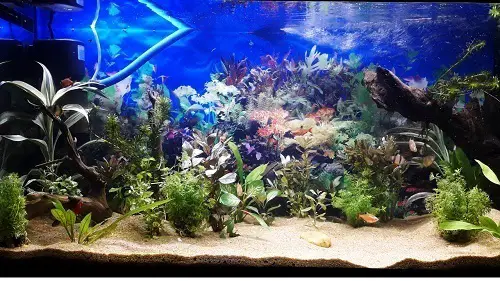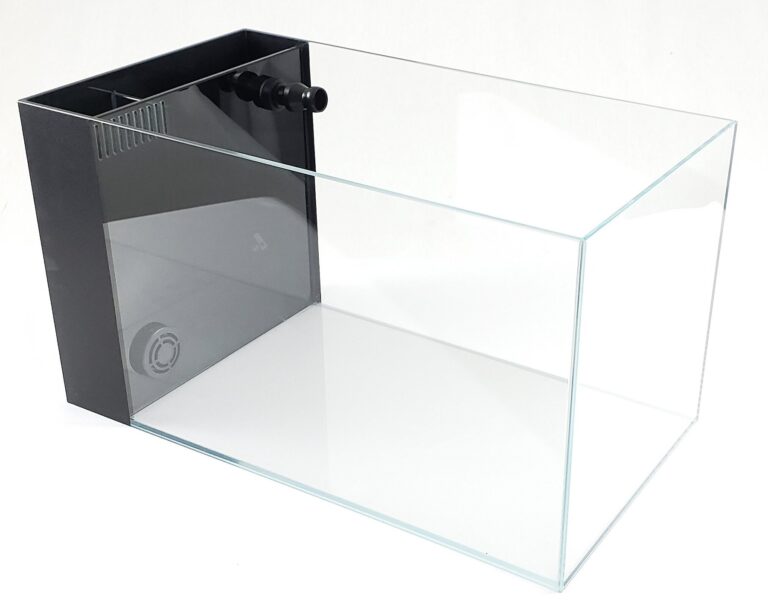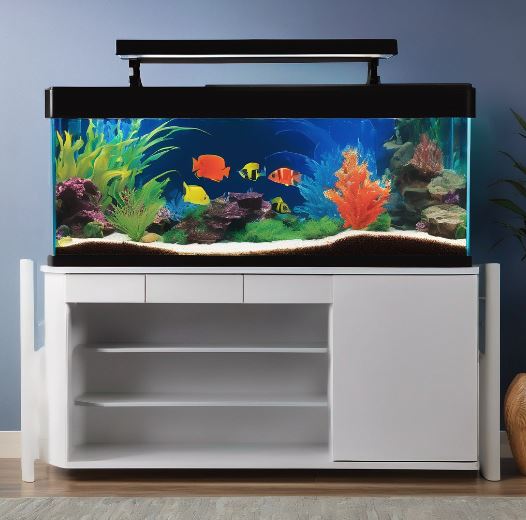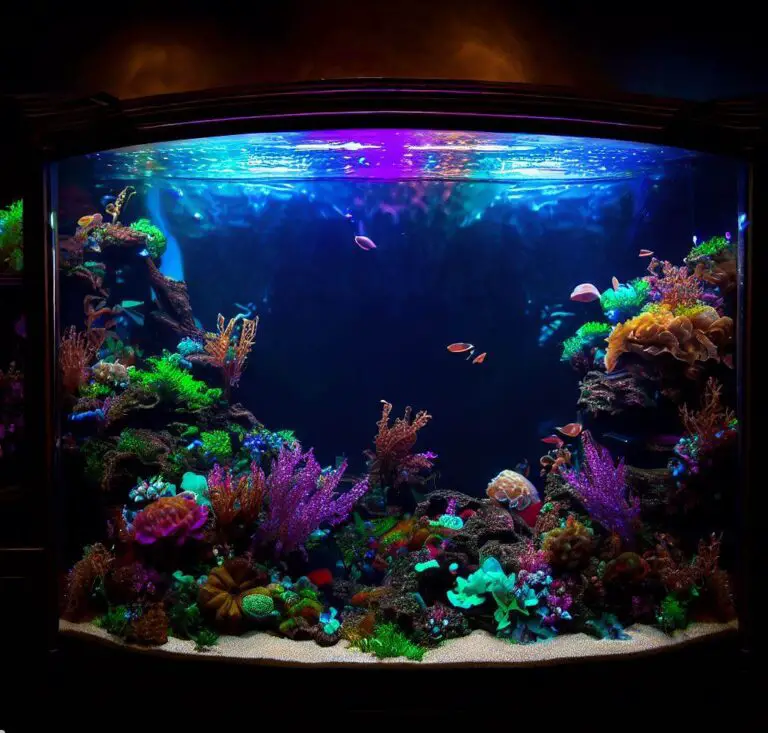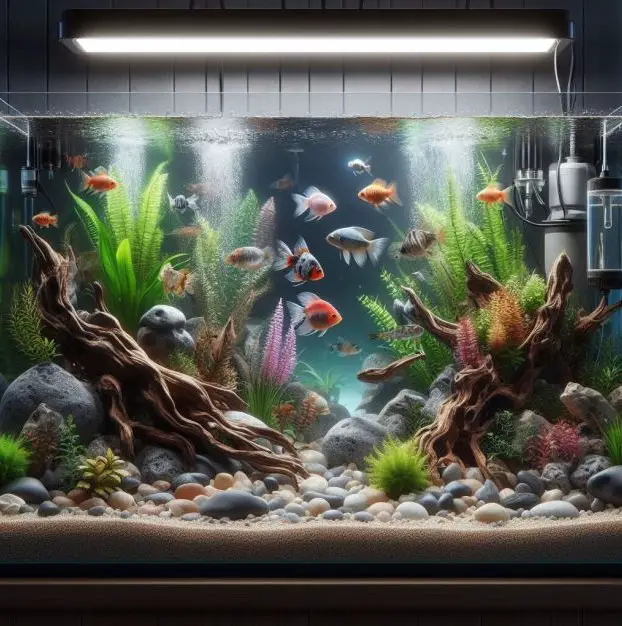120 Gallon Aquarium: Tips for Setting Up and Maintaining Your Large Tank
As an aquarium enthusiast, I have found that the 120-gallon aquarium is a popular choice among hobbyists. This tank size provides ample space for a variety of fish species and allows for creative aquascaping. Whether you are a beginner or an experienced aquarist, a 120-gallon aquarium can be a great addition to your home or office.
A 120 gallon aquarium is a sizable tank that offers ample space to house a variety of fish, plants, and decorations. Its large capacity allows for greater flexibility in designing a visually appealing and biologically diverse environment. Whether you are a beginner or an experienced aquarist, a 120 gallon aquarium provides an exciting opportunity to explore and experiment with different aquatic species and create a captivating display.

I will provide an overview of the 120-gallon aquarium, including the different types available and how to set one up. I will also discuss how to maintain your aquarium and select appropriate fish and plants.
I will cover common issues you may encounter and troubleshooting tips to solve them. By the end of this article, you will have a comprehensive understanding of the 120-gallon aquarium and be equipped with the knowledge to create a thriving aquatic environment in your own home.
- The 120-gallon aquarium is a popular choice for hobbyists due to its size and versatility.
- There are different types of 120-gallon aquariums available, each with unique features and benefits.
- Proper setup, maintenance, and fish and plant selection are key to creating a successful and healthy aquarium.
120 Gallon Aquarium Overview
As an aquarium enthusiast, I can confidently say that a 120-gallon aquarium is a great choice for those who want to take their fishkeeping hobby to the next level. With a capacity of 120 gallons, this aquarium size provides ample space for a variety of fish species, as well as room for decorations and equipment.
When it comes to choosing a 120-gallon aquarium, there are a few things to consider. First and foremost, you’ll want to decide whether you want a glass or acrylic tank.
Glass tanks are more affordable and scratch-resistant, while acrylic tanks are lighter and more durable. You’ll want to consider the dimensions of the tank, as well as whether it comes with a stand and filtration system.
One popular option for a 120-gallon aquarium is the SC Aquariums 120 Gallon Starfire Glass Tank. This tank is made in the USA and features high-quality, low-iron glass that provides excellent clarity.
It also comes with a built-in center overflow and plumbing kit, making it easy to set up and maintain.
Another great option is the Custom Aquariums 120 Gallon Fish Tank. This tank is made in the USA with the highest quality materials and can be customized to your specific needs.
It also comes with optional stands and filtration systems, making it a great choice for those who want a more personalized setup.
Overall, a 120-gallon aquarium is a great choice for those who want to create a stunning aquatic environment in their home or office. With the right equipment and maintenance, it can provide years of enjoyment and a beautiful centerpiece for any room.
Equipment for a 120 Gallon Aquarium
To ensure the success of your 120 gallon aquarium, it is essential to invest in high-quality equipment that meets the needs of your aquatic inhabitants. Here are some key equipment essentials:
1. Aquarium Tank
The first and most crucial piece of equipment is the aquarium tank itself. Opt for a tank made of glass or acrylic that is specifically designed for a 120 gallon capacity. Ensure that the tank is sturdy, leak-proof, and has a secure lid to prevent fish from jumping out.
2. Filtration System
A reliable filtration system is vital for maintaining water quality in your 120 gallon aquarium. Consider a combination of mechanical, chemical, and biological filtration to effectively remove debris, neutralize toxins, and promote beneficial bacteria growth.
3. Lighting
Proper lighting is essential for the health and growth of plants and fish in your aquarium. Choose a lighting system that provides the appropriate spectrum and intensity for your specific setup. LED lights are energy-efficient and offer customizable options to enhance the visual appeal of your aquarium.
4. Heater
Maintaining a stable water temperature is crucial for the well-being of your fish. Invest in a high-quality heater that can accurately regulate the temperature within your 120 gallon aquarium. Choose a heater with a built-in thermostat for precise control.
5. Substrate and Decorations
Selecting the right substrate and decorations not only enhances the aesthetic appeal of your aquarium but also provides hiding places and territories for your fish. Choose a substrate that is suitable for the species you plan to keep and add ornaments, rocks, and plants to create a natural and stimulating environment.
6. Water Test Kit
Regularly monitoring the water parameters in your 120 gallon aquarium is essential for maintaining optimal conditions. Invest in a reliable water test kit that can measure parameters such as pH, ammonia, nitrite, and nitrate levels. This will help you identify any imbalances and take corrective measures promptly.
Types of 120 Gallon Aquariums
When it comes to choosing a 120-gallon aquarium, there are several types to consider. Each type has its own unique features and benefits. I will discuss the most common types of 120-gallon aquariums.
Glass Aquariums
Glass aquariums are the most popular type of aquariums on the market. They are made of clear glass and come in various sizes and shapes. Glass aquariums are durable and scratch-resistant, making them a great choice for beginners. They also provide excellent visibility of the fish and other aquatic creatures.
Acrylic Aquariums
Acrylic aquariums are a more expensive option than glass aquariums, but they offer several benefits. They are lightweight, durable, and less prone to cracking or breaking. They also provide better insulation, which means they require less energy to heat and cool. Acrylic aquariums are also available in various shapes and sizes.
Reef-Ready Aquariums
Reef-ready aquariums are designed specifically for saltwater reef setups. They come with built-in overflow boxes, sumps, and plumbing, making it easier to set up a reef tank. Reef-ready aquariums are also available in glass and acrylic, and they come in various sizes.
Custom Aquariums
Custom aquariums are made to order and can be designed to fit any space or style. They can be made of glass or acrylic and can come with various features, such as built-in filtration, lighting, and stands. Custom aquariums are a great choice for those who want a unique and personalized aquarium setup.
Choosing the right type of 120-gallon aquarium depends on your needs, budget, and preferences. Whether you choose a glass or acrylic aquarium, reef-ready or custom, make sure to do your research and choose a reputable brand to ensure the best quality and longevity.
Setting Up Your 120 Gallon Aquarium
As a fish enthusiast, setting up a 120 gallon aquarium can be an exciting and rewarding experience. However, it is important to ensure that the aquarium is set up properly to provide a healthy environment for your fish. I will walk you through the steps to set up your 120 gallon aquarium.
Choosing the Right Location
The first step in setting up your 120 gallon aquarium is to choose the right location. The location you choose should be sturdy enough to support the weight of the aquarium and the water it will hold. It should also be near a power source for the equipment that will be used to maintain the aquarium.
When choosing a location, it is important to avoid areas that receive direct sunlight or are prone to temperature fluctuations. Direct sunlight can cause algae growth, while temperature fluctuations can stress your fish and make them more susceptible to disease.
Installing Filtration System
Once you have chosen the location for your aquarium, the next step is to install the filtration system. A good filtration system is essential for maintaining a healthy environment for your fish. There are several types of filtration systems available, including hang-on-back filters, canister filters, and sump filters.
When installing your filtration system, make sure to follow the manufacturer’s instructions carefully. It is also important to regularly clean and maintain the filter to ensure that it is working properly.
Adding Substrate and Decorations
After installing the filtration system, the next step is to add substrate and decorations to your aquarium. Substrate is the material that lines the bottom of the aquarium and provides a surface for beneficial bacteria to grow. There are several types of substrate available, including sand, gravel, and crushed coral.
When adding substrate, make sure to rinse it thoroughly to remove any debris or dust. It is also important to add decorations, such as rocks, driftwood, and plants, to provide hiding places for your fish and create a natural-looking environment.
Setting up a 120 gallon aquarium requires careful planning and attention to detail. By choosing the right location, installing a good filtration system, and adding substrate and decorations, you can create a healthy and beautiful environment for your fish.
Water Conditions and Maintenance
Maintaining optimal water conditions is crucial for the health and well-being of your fish. Here are some key factors to consider:
1. Water Temperature
Most tropical fish species thrive in water temperatures between 75°F and 82°F. Use a reliable heater to maintain a stable temperature within this range. Monitor the temperature regularly and make adjustments as necessary.
2. Water Quality
Regular water testing is essential to ensure that the ammonia, nitrite, and nitrate levels are within acceptable limits. Perform partial water changes to maintain water quality and remove accumulated waste and toxins. Aim for a pH level between 6.5 and 7.5, depending on the specific needs of your fish species.
3. Feeding and Nutrition
Provide a balanced and varied diet to meet the nutritional needs of your fish. Research the specific dietary requirements of each species and feed them a combination of high-quality flakes, pellets, frozen or live foods. Avoid overfeeding, as it can lead to poor water quality and health issues.
4. Cleaning and Maintenance
Regularly clean the aquarium glass, decorations, and filter media to prevent the buildup of algae and debris. Use a gravel vacuum to remove waste from the substrate during water changes. Trim and prune plants as needed to maintain a healthy and aesthetically pleasing environment.
Choosing Fish for Your 120 Gallon Aquarium
One of the most exciting aspects of owning a 120 gallon aquarium is the opportunity to house a diverse range of fish species. However, it is essential to select fish that are compatible with each other in terms of size, temperament, and water requirements. Here are some popular fish species suitable for a 120 gallon aquarium:
– Angelfish
– Discus
– Rainbowfish
– Tetras
– Gouramis
– Cichlids
Before adding fish to your aquarium, research their specific needs and ensure they can coexist peacefully with other species. Consider factors such as water temperature, pH levels, and dietary requirements to create a harmonious and thriving community.
Understanding Fish Behavior
Understanding fish behavior is essential when selecting fish for your aquarium. Some fish are bottom-dwellers, while others prefer to swim in the middle or top of the tank. It is important to provide a variety of hiding spots and swimming areas for your fish to ensure they are comfortable and happy in their environment.
Some fish are more active during the day, while others are more active at night. It is important to consider the activity level of the fish when selecting them for your aquarium, as some fish may be more active than others and require more space to swim and explore.
Selecting the right fish species for your 120-gallon aquarium requires careful consideration of their size, temperament, and behavior. By doing your research and understanding the needs of your fish, you can create a beautiful and thriving aquatic community in your aquarium.
Aquatic Plants for 120 Gallon Aquarium
Choosing Suitable Plants
When it comes to selecting plants for a 120 gallon aquarium, it’s important to choose plants that will thrive in the conditions of your tank. Some popular options for a 120 gallon aquarium include Amazon swords, Java ferns, Anubias, and Vallisneria. These plants can add color, texture, and oxygen to your aquarium, creating a beautiful and healthy environment for your fish.
It’s important to consider the lighting requirements of your plants when selecting them for your aquarium. Some plants require high levels of light, while others can thrive in low-light conditions. Some plants may require specific water temperatures or pH levels to grow properly. Be sure to research the specific needs of any plants you are considering before adding them to your aquarium.
Plant Care
Proper care is essential for the health and longevity of your aquatic plants. In addition to meeting their specific lighting and water requirements, it’s important to provide regular maintenance for your plants. This may include trimming dead or damaged leaves, removing any debris or algae that accumulates on the leaves, and fertilizing the plants as needed.
One important factor to keep in mind is the potential for plants to outgrow your tank. Be sure to regularly monitor the growth of your plants and trim them back as needed to prevent overcrowding. Be mindful of any plants that may be prone to spreading rapidly and taking over your tank.
Overall, adding aquatic plants to your 120 gallon aquarium can be a great way to enhance the beauty and health of your tank. By selecting suitable plants and providing proper care, you can create a thriving underwater ecosystem for your fish to enjoy.
Troubleshooting Common Issues
As a 120-gallon aquarium owner, I have experienced my fair share of common issues that can arise in any aquarium. Two main categories of problems that can occur: water quality issues and fish health problems.
Water Quality Issues
Maintaining good water quality is crucial for the health and well-being of your fish. Here are some common water quality issues and how to troubleshoot them:
- Cloudy Water: Cloudy water can be caused by a variety of factors, including an improperly cycled new tank, too much biomass for the tank size, overfeeding, and inadequate mechanical filtration. To troubleshoot this issue, try reducing the amount of food you feed your fish, increasing the frequency of water changes, and upgrading your mechanical filtration system.
- Ammonia Spikes: Ammonia spikes can occur when there is an excess of organic waste in the tank. This can be caused by overfeeding or inadequate biological filtration. To troubleshoot this issue, try reducing the amount of food you feed your fish, increasing the frequency of water changes, and adding more biological filtration media to your filter.
- Algae Overgrowth: Algae overgrowth can be caused by excess light, excess nutrients, and poor water circulation. To troubleshoot this issue, try reducing the amount of light your tank gets each day, reducing the amount of food you feed your fish, and increasing water circulation by adding a powerhead or adjusting the position of your filter.
Fish Health Problems
Keeping your fish healthy is just as important as maintaining good water quality. Here are some common fish health problems and how to troubleshoot them:
- Ich: Ich is a common parasite that can affect freshwater fish. It appears as small white spots on the fish’s body and fins. To troubleshoot this issue, try increasing the temperature of your tank to 86°F for several days, adding aquarium salt, and treating with an ich medication.
- Fin Rot: Fin rot is a bacterial infection that can cause the fins of your fish to deteriorate. It can be caused by poor water quality, injury, or stress. To troubleshoot this issue, try improving the water quality in your tank, removing any sharp objects that could injure your fish, and treating with a fin rot medication.
- Swim Bladder Disorder: Swim bladder disorder can cause your fish to have difficulty swimming or floating properly. It can be caused by overfeeding, constipation, or infection. To troubleshoot this issue, try reducing the amount of food you feed your fish, feeding your fish a diet that includes some high-fiber foods, and treating with a swim bladder medication.
By troubleshooting these common issues, you can keep your 120-gallon aquarium healthy and thriving.
Conclusion
120-gallon aquarium is a great choice for those who want to keep a large number of fish and create a stunning aquatic display. It is important to note that a tank of this size requires a sturdy stand and careful consideration of its weight.
When choosing a 120-gallon aquarium, it is important to consider the dimensions, materials, and features of the tank. The SC Aquarium 120 Gallon StarFire Glass Tank is a popular option that features low iron glass and a built-in center overflow with plumbing kit included.
It is also important to consider the weight of the tank, which can range from 400 to 1150 pounds depending on the materials used. A sturdy stand is essential to support the weight of the tank and ensure the safety of both the fish and the tank itself.
Setting up and maintaining a 120 gallon aquarium is an exciting and rewarding endeavor. By carefully selecting compatible fish species, maintaining optimal water conditions, and providing proper care, you can create a captivating underwater world that will be the envy of any fish enthusiast.
Remember to regularly monitor water parameters, perform routine maintenance, and seek advice from reputable sources to ensure the long-term success of your 120 gallon aquarium.
Frequently Asked Questions
What are the dimensions of a 120 gallon aquarium?
The standard dimensions for a 120 gallon aquarium are 48″ x 24″ x 24″. However, it’s important to note that there may be slight variations in dimensions depending on the manufacturer.
How long is a 120 gallon tank in feet?
A 120 gallon tank is approximately 4 feet long.
How much does a 120 gallon tank with water weigh?
A 120 gallon tank filled with water can weigh up to 1,400 pounds. It’s important to make sure that the surface the tank is placed on can support this weight.
What is the price of a 120 gallon aquarium?
The price of a 120 gallon aquarium can vary depending on the brand, quality, and features. On average, a 120 gallon aquarium can cost between $500 to $2,500.
Where can I find a 120 gallon aquarium for sale?
You can find 120 gallon aquariums for sale at pet stores, aquarium specialty stores, and online retailers such as Amazon and Petco.
What is the weight limit for a 120 gallon aquarium stand?
The weight limit for a 120 gallon aquarium stand can vary depending on the material and construction of the stand. It’s important to check the manufacturer’s specifications for weight limits before purchasing a stand. Generally, a sturdy stand made of metal or hardwood can support the weight of a 120 gallon aquarium.
How many fish can I keep in a 120 gallon aquarium?
The number of fish you can keep in a 120 gallon aquarium depends on the species and their adult size. As a general guideline, aim for a stocking density of one inch of fish per gallon of water. However, it is crucial to consider factors such as territorial behavior, compatibility, and the specific needs of each species.
Do I need a protein skimmer for a 120 gallon aquarium?
Protein skimmers are not a necessity for a 120 gallon aquarium, especially if you maintain proper filtration and regular water changes. However, if you plan to keep a high bioload or desire additional water quality control, a protein skimmer can be a beneficial addition.
How often should I perform water changes in a 120 gallon aquarium?
Regular water changes are essential for maintaining optimal water quality. Aim to perform a 20-30% water change every 1-2 weeks. However, monitor the water parameters closely and adjust the frequency and volume of water changes based on the specific needs of your aquarium.
Can I keep live plants in a 120 gallon aquarium?
Yes, a 120 gallon aquarium provides ample space and lighting for a thriving planted tank. Choose plant species that are compatible with your water parameters and lighting conditions. Provide appropriate fertilization and CO2 supplementation if necessary.
How can I prevent algae growth in my 120 gallon aquarium?
Algae growth can be controlled by maintaining proper lighting duration, avoiding excessive nutrient levels, and regular maintenance. Ensure that your aquarium receives an appropriate balance of light and darkness, and consider adding algae-eating fish or invertebrates to help control algae growth naturally.
Can I mix freshwater and saltwater fish in a 120 gallon aquarium?
It is not recommended to mix freshwater and saltwater fish in the same aquarium. The water parameters and salinity requirements for these two types of fish are significantly different, and attempting to create a brackish environment can lead to stress and health issues for both species.
